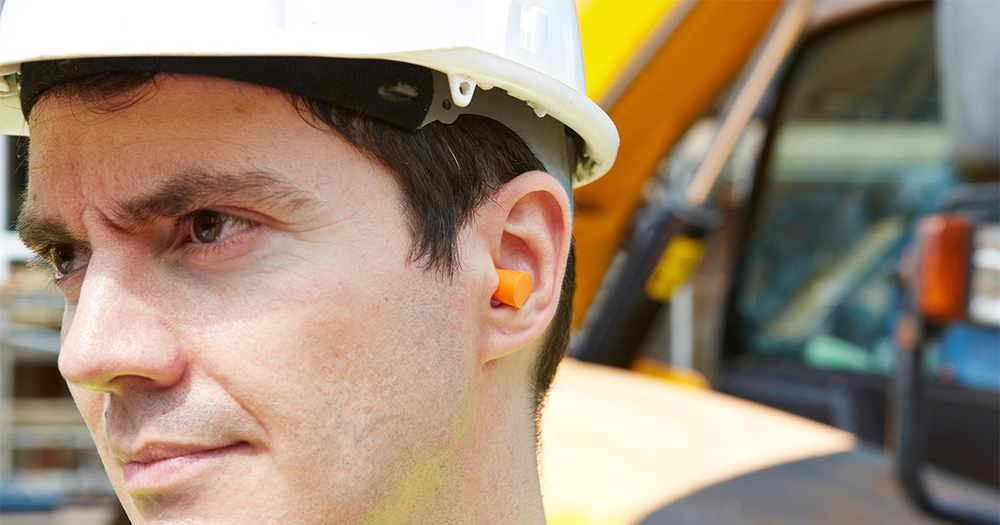
Hearing protection equipment is more than just a convenience. For many, using noise reduction devices to turn down the volume now is necessary to avoid hearing loss later in life.
The Center for Disease Control warns that people who are routinely exposed to 85 dBa (weighted decibels) or more are at risk of mild to severe hearing loss. For most people, this is not a concern. New York City, the loudest city in America, hovers around 70 dBa. This background noise is enough to raise your blood pressure, probably nor enough to impact your hearing.
However, those who work in loud settings such as factories or construction sites are exposed to roughly 95 dBa of background noise on a regular basis. Each year, an estimated 22 million workers are exposed to sounds that put their hearing at risk. If action is not taken, they are at risk of moderate or severe hearing loss. The more ear canal damage can be prevented now, the lesser degree of hearing loss they will have later on.
The responsibility to provide hearing protection equipment falls on employers. Federal and state occupational health agencies require that employers provide hearing protection equipment when necessary. This practice is not just good health; it is good business. Employers who take advantage of hearing protection equipment are not just allowing their employees to stay healthy; they are allowing them to stay productive, as well. This investment reduces long-term costs to businesses.

Choosing the Best Hearing Equipment
Hearing protection equipment is any device that dulls sound before it enters inside the ear canal. There are many different kinds of devices, so how do you decide what type of hearing protection device is best for you? It is important to consider how much hearing reduction you need and the work you will be doing.
Some questions for consideration include:
Luckily, technological advancements in noise reduction devices and hearing aids have come a long way. Having access to the right information can help you determine the best type of hearing protection for your hearing needs, at a cost that works for your budget.
It is important to determine the amount of noise reduction that is needed. Worksites do not usually reach 95 dBa of background noise, which means that most workers do not need to reduce their hearing by more than 10 dBa to reach 85 dBa, the maximum weighted decibel level as recommended by the Center for Disease Control.
The exception is those who are exposed to louder equipment. Devices such as jackhammers and chainsaws may reach over 100 dBa. Those workers should consider wearing double hearing protection (earmuffs over earplugs). Those who are exposed to any single noise impulse level that exceeds 140 dBa should also wear double hearing protection.
Buyers should be cautious of reducing noise by too much. Wearing too much protection can impact sound quality, leaving workers feeling isolated and unaware of the sounds around them. It is suggested not to go below the 75-85 dBa range.
The Noise Reduction Rating (NRR) is labeled on all hearing protection equipment. This shows the amount of hearing protection detected when it was tested in a laboratory. The NRR can provide a starting estimate for how many decibels will be blocked, but research indicates that NRR often does not translate well to real life. For more accurate measurement, use a Hearing Protection Device Well-Fit, which performs a hearing test in real life.
Ear Plugs are thin tubes that stick right into your ear canal. To insert foam plugs, you roll the plug into a thin cylinder, pull it up on your ear with your opposite hand, and put it inside the ear canal. In the ear, it slowly expands until it fits snugly. Foam plugs are generally effective but absent a device that allows you to safely store them, they are not designed to be reused. Baseline Equipment offers several styles of plugs to meet your needs.
The Moldex Sparkplugs are low technology and a comfortable option. These foam earplugs come unattached to any sort of cord, making for simple and convenient use. You should not mistake their colorful patterns as an indication that they are less serious about blocking sound. The Moldex Sparkplugs have an NRR of 33, making them suitable for most noisy environments.
Moldex Sparkplugs are relatively inexpensive. One box of Moldex Sparkplugs comes with 200 pairs at the cost of $34.
Just like the Moldex Sparkplugs, the Corded Moldex Sparkplugs are foam plugs with colorful swirls and an NRR of 33. However, Corded Moldex Sparkplugs come with a cord attached to the plugs. Users can rest the cord on their neck while wearing the device. This makes for a more reusable hearing protection device by allowing users to more easily keep track of the plugs while not using them.
Corded Moldex Sparkplugs cost $36 for a box of 100 pairs of corded plugs. While this cost is higher than the standard Moldex Sparkplugs, the investment in this style of earplugs may pay off in the long term for those looking to reuse their hearing protection device.
Similar to Corded Moldex Sparkplugs, ReadyMax PermaPlugs are easy to reuse. The PermaPlugs are a two-piece design. They have a stiff core to make insertion easy, while still featuring a soft exterior. The plugs fit neatly onto a tethered casing, allowing them to be easily removed and replaced.
ReadyMax Permaplugs have an NRR of 27. They come at a unit price of $1.19 for purchases between 1 and 99 sets. For purchases of over 100 sets, the unit price rises to $1.14.
Finally, the ReadyMax Zip-Out Ear Plugs offer instant hearing protection that attaches to your hardhat. The earplugs are attached to a cord that is attached to the inside of the hardhat, making for easy storage.
Upon receiving the Zip-Out Ear Plugs, you can remove the adhesive backing and press it firmly against your helmet. Once it is firmly in place, you can easily unzip the zipper, allowing the corded earplugs to be used by whoever wears the helmet.
The NRR is 27, making for effective noise reduction.
The ReadyMax Zip-Out Ear Plugs are convenient for keeping easy track of your earplugs and for using while wearing a construction hat. For orders of 1 to 23 sets, the unit price is $6.45. For bulk orders of more than 24 sets, the unit price is $6.00.
Earmuffs, unlike earplugs, block out noise by covering the entire outer ear. They feature a band that arches across the top of the head, preventing the earmuffs from falling off.
Earmuffs come in various sizes and have noise-canceling abilities. The main drawback of earmuffs is that if the seal around the ear is broken, their ability to keep out noise is lessened. This can be a problem for those that wear glasses or have thick sideburns.
HexArmor Ceros Earmuffs Safety Helmet
Most earmuffs present real difficulty for those who work with headgear. They are at risk of either not fitting on the head at the same time as the headgear or having their seal broken by the headgear.
Baseline Equipment dodges this issue with the HexArmor Ceros Earmuffs Safety Helmet, a device that is designed to offer noise reduction and headgear at the same time. This earmuff helmet mashup attaches either end of earmuffs to the side of the helmet. There is no band that covers the entire head.
Not only that, the earmuffs portion nestles into the back of the helmet when it is not being used. This allows for the earmuffs to be easily removed when they are not needed on the job.
Baseline Equipment offers four versions. The HexArmor Ceros K1C Earmuffs Safety Helmet has an NRR of 22. This costs $30 per unit. The HexArmor Ceros K2C Earmuffs Safety Helmet has an NRR of 25. This costs $33 per unit.
The HexArmor Keros K1M Earmuffs Safety Helmet has an NRR of 22 and includes a facemask. It costs $34 per unit. The HexArmor Keros K1M Magnetic Earmuffs Safety Helmet Accessory has an NRR of 21. It costs $45.50 per unit.
If you are unsure which device best meets your hearing needs, consulting with an audiologist is your best bet. Audiologists have the experience and training to assess your hearing needs.
Audiologists can also help to evaluate your work environment. By considering the noise level and workplace demands, the audiologist can better determine hearing protection that suits your needs
